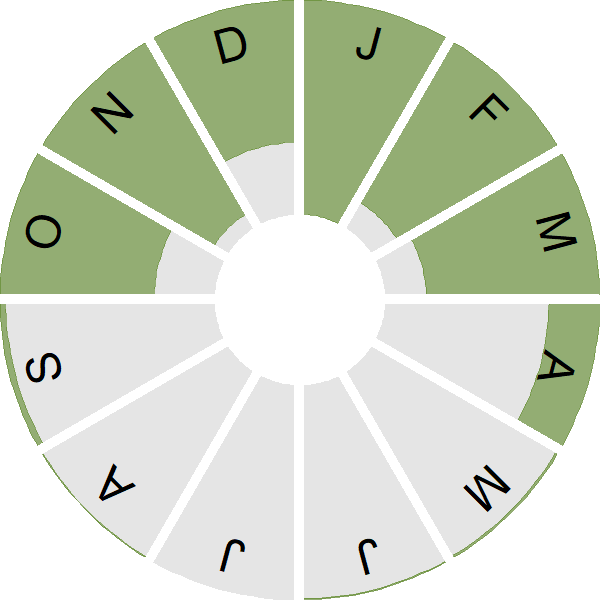Great Grey Shrike

Introduction
This striking, grey, black and white passerine is a winter visitor to UK heathlands in small numbers.
The Great Grey Shrike has always been a scarce winter visitor to the UK. Numbers fluctuate wildly and in some winters fewer than 10 birds might be recorded. Like most birds escaping the frozen north, the numbers occurring here are dependent on the availability of food (small birds and rodents in the case of Great Grey Shrike) closer to their breeding grounds.
In the UK, lowland heathland is the preferred habitat where it is well known for creating larders, typically a thorn bush in which food is stored impaled. Some individuals return to traditional sites, while others are more transient. Consequently the Bird Atlas 2007–11 distribution map based on four winters shows a wider distribution than might be expected in a single winter.

Key Stats
Identification
Songs and Calls
Call:
Status and Trends
Conservation Status
Population Size
Population Change
Although the occasional Great Grey Shrike is recorded in the UK during the breeding season, there have been no confirmed breeding records for this species [Eaton & the Rare Breeding Birds Panel 2021]. Great Grey Shrike is predominantly a scarce migrant, with only a very small number of individuals remaining in the UK over winter [White & Kehoe 2024]. There has been a noticeable decline in the number ofindividuals recorded in the UK in the past decade, although there is no statistically significant long-term trend [White & Kehoe 2024]; at a European scale, the population trend is also decreasing [BirdLife International 2021].
Distribution
The winter distribution of Great Grey Shrikes is wide but strangely clumped, extending through most of Britain except western Scotland; there were no accepted winter records in Ireland. East coast records often involve late passage birds. Extensive areas of prime habitat, such as the New Forest, Dartmoor, Exmoor and the Thames Basin Heaths, regularly hold more than one active winter territory.
Occupied 10-km squares in UK
or view it on Bird Atlas Mapstore.
or view it on Bird Atlas Mapstore.
European Distribution Map
Distribution Change
Change in occupied 10-km squares in the UK
or view it on Bird Atlas Mapstore.
Seasonality
Great Grey Shrike is a scarce autumn passage migrant and rare winter visitor. Some individuals are long-staying and may return to the same location year after year.
Weekly pattern of occurrence
The graph shows when the species is present in the UK, with taller bars indicating a higher likelihood of encountering the species in appropriate regions and habitats.

Movement
Britain & Ireland movement
Foreign locations of birds ringed or recovered in Britain & Ireland
Dots show the foreign destinations of birds ringed in Britain & Ireland, and the origins of birds ringed overseas that were subsequently recaptured, resighted or found dead in Britain & Ireland. Dot colours indicate the time of year that the species was present at the location.
- Winter (Nov-Feb)
- Spring (Mar-Apr)
- Summer (May-Jul)
- Autumn (Aug-Oct)

European movements
EuroBirdPortal uses birdwatcher's records, such as those logged in BirdTrack to map the flows of birds as they arrive and depart Europe. See maps for this species here.
The Eurasian-African Migration Atlas shows movements of individual birds ringed or recovered in Europe. See maps for this species here.
Biology
Productivity and Nesting
Nesting timing
Egg measurements
Clutch Size
Survival and Longevity
Survival is shown as the proportion of birds surviving from one year to the next and is derived from bird ringing data. It can also be used to estimate how long birds typically live.
View number ringed each year in the Online Ringing Report.
Biometrics
Wing length and body weights are from live birds (source).
Ring Size
Classification, names and codes
Classification and Codes
- Order: Passeriformes
- Family: Laniidae
- Scientific name: Lanius excubitor
- Authority: Linnaeus, 1758
- BTO 2-letter code: SR
- BTO 5-letter code: GRGSH
- Euring code number: 15200
Alternate species names
- Catalan: botxí septentrional
- Czech: tuhýk šedý
- Danish: Stor Tornskade
- Dutch: Klapekster
- Estonian: hallõgija
- Finnish: isolepinkäinen
- French: Pie-grièche grise
- Gaelic: Feòladair-glas
- German: Raubwürger
- Hungarian: nagy orgébics
- Icelandic: Grásvarri
- Irish: Mórscréachán Liath
- Italian: Averla maggiore
- Latvian: liela cakste
- Lithuanian: plešrioji medšarke
- Norwegian: Varsler
- Polish: srokosz (europejski)
- Portuguese: picanço-real-nortenho
- Slovak: strakoš velký
- Slovenian: veliki srakoper
- Spanish: Alcaudón norteño
- Swedish: varfågel
- Welsh: Cigydd Mawr
- English folkname(s): Butcher Bird, Ash-coloured Shrike

